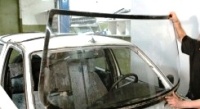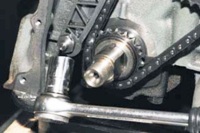The braking system of your car is equipped with a vacuum booster and is quite effective
Decrease in braking efficiency, skidding of the car during braking should be a signal to urgently check the brakes.
Regularly check the brake fluid level in the master cylinder reservoir.
The brake fluid level should be between the "MAX" and "MIN" marks on the reservoir wall (approximately at the level of the reservoir connector).

A drop in the fluid level indicates either a leak of brake fluid from the system or excessive wear on the brake pads.
If the lamp on the instrument panel lights up, signaling a low level of brake fluid, do not rush to add it immediately, first check the thickness of the brake pads: maybe it's time to replace the pads?
Car manufacturers recommend replacing all brake fluid in the system after a certain period.
Some drivers disregard this advice because the fluid in the tank seems clean enough to them, and completely in vain.
The fact is that brake fluid is very hygroscopic - it absorbs moisture from the air, and this moisture over time not only destroys the surfaces of brake cylinders, pipelines and, as a result, leads to premature failure of brake system components, but also significantly reduces the boiling point of the brake fluid.
The normal boiling point of the brake fluid "Neva" is 190 °C, "Tom" - 210 °C, "Rosa" - 260 °C.
With frequent hard braking, the front wheel disc brakes get very hot and with a high water content, the brake fluid can boil, which usually leads to brake failure.
In order not to expose yourself in the future to unforeseen expenses for repairing not only the brake system, but the entire car, it is better to change the fluid in the brake system in a timely manner.
Article - Bleeding the brake system
If the brake pedal becomes "soft" and becomes "harder" after several consecutive applications, this indicates the presence of air in the hydraulic brake actuator.
The brakes must be bled to bleed air from the system. The procedure for bleeding the brakes is quite simple, but it is more convenient to carry it out with an assistant.
Checking the brake system
The reason for the loss of braking efficiency may be the unsatisfactory operation of the vacuum booster.
For its express check, press the brake pedal several times with the engine off to remove the vacuum in the booster, and then, while holding the pedal, start the engine.
If the pedal drops a little after starting the engine, the vacuum booster is working.
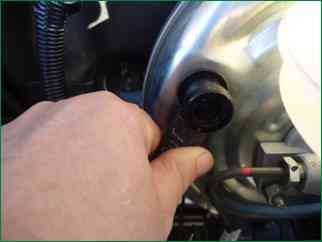
If the pedal remains stationary, check the integrity and reliability of the hose to the check valve of the vacuum booster and to the engine intake pipe. Replace or repair the defective hose.
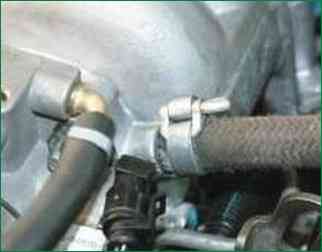
If the hose is good, the vacuum booster needs to be replaced
If braking is accompanied by beating and pulsing of the brake pedal, you should first check the condition of the front disc brakes.
With the car on a jack, remove the front wheel and check the mobility of the brake pads.
To do this, try moving the pads in the caliper sockets through the window in the bracket with a screwdriver.
If the pads cannot be moved away from the brake disc, this means that the pads have lost their mobility in the caliper sockets or the piston in the brake cylinder has “jammed”.
Jamming the piston of the brake cylinder leads to the constant braking of the corresponding wheel when the pedal is released and the car skids when braking.
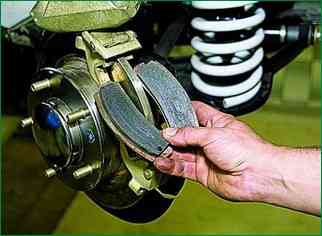
Remove the bracket (see "Replacing the pads of the Niva Chevrolet front wheels" and check the mobility of the pads.
If they move with difficulty, clean the end surfaces of the bases of the pads and the socket in the caliper from dirt and rust, ensuring completely free movement of the pads.
At the same time, check the thickness of the overlays pads. If it is less than 3 mm, replace the pads.

Inspect the brake disc
The thickness of the brake disc must be at least 9.5 mm.
The surface of the disc must be even and smooth on both sides.
If the surface of the disc is covered with rust in places, which usually happens after a long parking of the car with dry brakes, try cleaning the working surface with a fine emery cloth.
If this procedure does not help, you will have to give the discs for grinding or replace them with new ones.
The parking brake is actuated by a cable connecting the parking brake lever and the rear brake pad control mechanism.
Many drivers try to use the parking brake as little as possible to prolong its life, and achieve the opposite result.
If you do not use the parking brake, dirt and moisture stagnate in the cable sheaths, the cable becomes rusty, stops moving and breaks.
Therefore, use the parking brake when necessary, but do not forget to adjust its drive from time to time.
The process of adjusting the parking brake is described in detail in "Adjusting the parking brake Niva Chevrolet"







